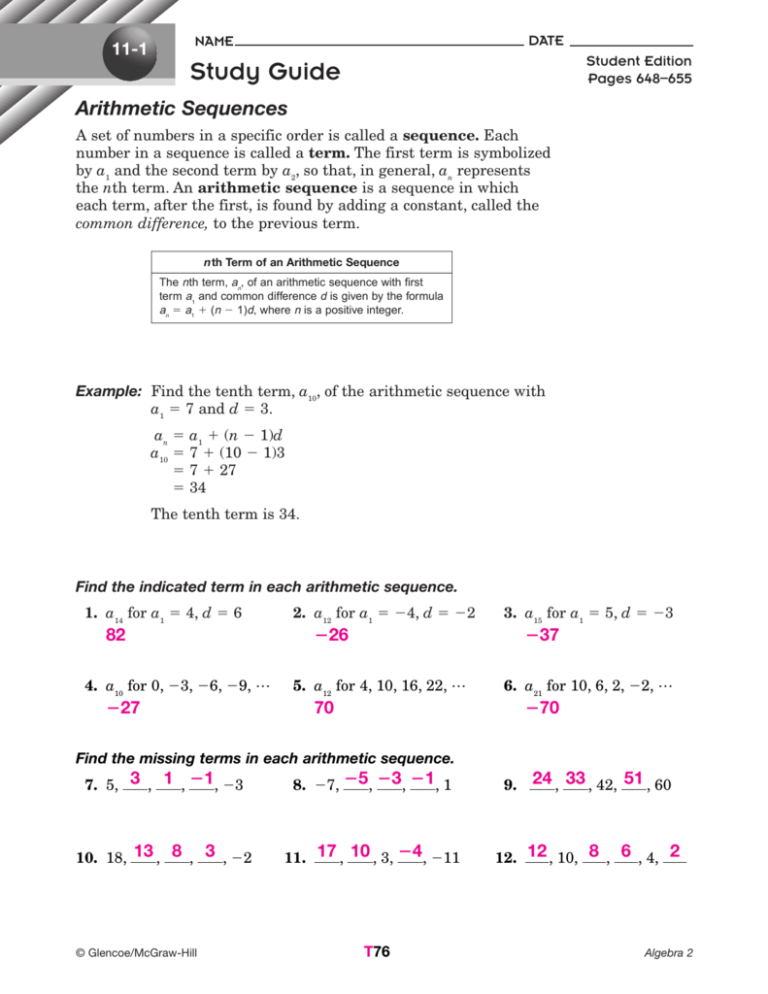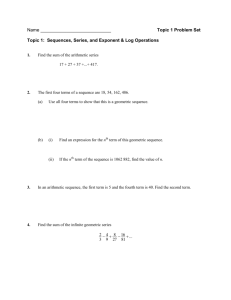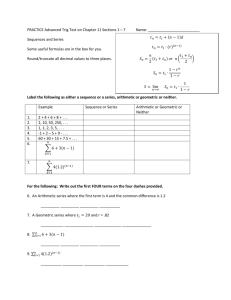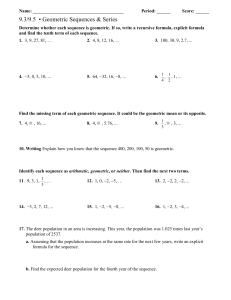Study Guide
advertisement

11-1
DATE
NAME
Student Edition
Pages 648–655
Study Guide
Arithmetic Sequences
A set of numbers in a specific order is called a sequence. Each
number in a sequence is called a term. The first term is symbolized
by a1 and the second term by a2, so that, in general, an represents
the nth term. An arithmetic sequence is a sequence in which
each term, after the first, is found by adding a constant, called the
common difference, to the previous term.
nth Term of an Arithmetic Sequence
The n th term, an, of an arithmetic sequence with first
term a1 and common difference d is given by the formula
an 5 a1 1 (n 2 1)d, where n is a positive integer.
Example: Find the tenth term, a10, of the arithmetic sequence with
a1 5 7 and d 5 3.
an 5 a1 1 (n 2 1)d
a10 5 7 1 (10 2 1)3
5 7 1 27
5 34
The tenth term is 34.
Find the indicated term in each arithmetic sequence.
1. a14 for a1 5 4, d 5 6
82
4. a10 for 0, 23, 26, 29, …
227
2. a12 for a1 5 24, d 5 22
3. a15 for a1 5 5, d 5 23
5. a12 for 4, 10, 16, 22, …
6. a21 for 10, 6, 2, 22, …
226
237
270
70
Find the missing terms in each arithmetic sequence.
7. 5, 3 , 1 , 21, 23
8. 27, 25, 23, 21, 1
10. 18, 13 , 8 , 3 , 22
11. 17 , 10 , 3, 24, 211
© Glencoe/McGraw-Hill
T76
9.
24 , 33 , 42, 51 , 60
12. 12 , 10, 8 , 6 , 4, 2
Algebra 2
DATE
NAME
11-2
Student Edition
Pages 656–661
Study Guide
Arithmetic Series
The indicated sum of the terms of a sequence
is called a series. The symbol Sn is used to
represent the sum of the first n terms of a
series. Since an 5 a1 1 (n 2 1)d, substitute
this into the formula
n
Sn 5 2 (a1 1 an) and get another formula for Sn,
Sum of an Arithmetic Series
The sum, Sn, of the first n terms of
an arithmetic series is given by the
following formula.
Sn 5
n
(a1 1
2
an )
n
Sn 5 [2a1 1 (n 2 1)d].
2
Example: Find the sum of the first 20 terms of an arithmetic series
where a1 5 10 and d 5 3.
n
Sn 5 2 [2a1 1 (n 2 1)d]
20
S20 5 [2(10) 1 (20 2 1)3]
2
5 770
Sigma notation can also be used to express an arithmetic series.
4
Example: Find
S
k51
S
k51
(2k 2 3).
(2k 2 3) 5 2(1) 2 3 1 2(2) 2 3 1 2(3) 2 3 1 2(4) 2 3
5 21
1
1
1
3
1
5
58
{
{
{
{
4
Find Sn for each arithmetic series described.
1. a1 5 12, an 5 100, n 5 12
2. a1 5 50, an 5 250, n 5 15
2300
672
1
3. a1 5 42, n 5 8, d 5 6
4. a1 5 4, n 5 20, d 5 22
1
126
55
5. 8 1 6 1 4 1 … 1 210
210
1683
25
20
7.
S
n51
2
6. 3 1 6 1 9 1 … 1 99
(2n 1 1)
8.
340
S
n55
x21
294
9. the first 50 positive odd integers
10. the first 100 positive multiples of 5
2500
25,250
Find the first three terms of each arithmetic series.
11. a1 5 7, an 5 83, Sn 5 900
12. a1 5 5, an 5 200, Sn 5 4100
7, 11, 15
© Glencoe/McGraw-Hill
5, 10, 15
T77
Algebra 2
DATE
NAME
11-3
Student Edition
Pages 662–669
Study Guide
Geometric Sequences
A geometric sequence is a sequence in which each term after
the first can be found by multiplying the preceding term by a
constant, called the common ratio. The common ratio, r, can be
found by dividing any term by the preceding term. The terms
between any two nonconsecutive terms of a geometric sequence
are called geometric means.
n th Term of the Geometric Sequence
The n th term, an , of a geometric sequence
with first term a1 and common ratio r is
given by either of the following formulas.
an 5 an 2 1r or an 5 a1r n 2 1
Example: Write the first four terms of a geometric sequence in which
a1 5 3 and r 5 2. Find each term using the formula
an 5 a1r n 2 1.
a1
a2
3
3?2
3
6
a3
3 ? 22
12
a4
3 ? 23
24
The first four terms are 3, 6, 12, and 24.
Find the nth term of each geometric sequence.
1. a1 5 210, r 5 4, n 5 2
2. a1 5 4, r 5 3, n 5 9
240
26,244
1
1
3. a1 5 214, r 5 22 , n 5 5
2
4. a1 5 26, r 5 22 , n 5 8
7
8
3
64
5. a3 5 9, r 5 23, n 5 7
6. a4 5 16, r 5 2, n 5 10
729
1024
3
7. a5 5 21, r 5 21, n 5 100
1
8. a3 5 8 , r 5 2 , n 5 6
21
3
64
1
1
2
9. a4 5 81 , r 5 3 , n 5 5
10. a1 5 8, r 5 3 , n 5 5
1
243
1
128
81
1
11. a3 5 10 , r 5 10 , n 5 6
12. a4 5 254, r 5 23, n 5 6
2486
1
10,000
© Glencoe/McGraw-Hill
T78
Algebra 2
DATE
NAME
11-4
Student Edition
Pages 670–675
Study Guide
Geometric Series
The indicated sum of the terms of a geometric sequence is called
a geometric series.
Sum of a Geometric Series
The sum Sn of the first n terms of a geometric series is given by
a 2 a rn
Sn 5 11 2 r1 or Sn 5
a1(1 2 r n )
, where
12r
r Þ 1.
Example: Find the sum of the first seven terms of the geometric
series for which a1 5 4 and r 5 23.
a 2 a rn
Sn 5 11 2 r1
4 2 4(23)7
S7 5
1 2 (23)
5 2188
The sum of the first seven terms is 2188.
Sigma notation can also be used to express a geometric series.
5
Example: Write
S 2(3 ) in expanded form and find the sum.
j
j51
5
S 2(3 ) 5 2(3 ) 1 2(3 ) 1 2(3 ) 1 2(3 ) 1 2(3 )
j
j 51
1
2
3
4
5
5 6 1 18 1 54 1 162 1 486
5 726
Find the sum of each geometric series.
1. 6 1 18 1 54 1 … to 6 terms
2. 10 1 5 1
2184
19
1
3
8
5
2
1 … to 5 terms
3. a1 5 3, r 5 3, n 5 4
4. a1 5 8, r 5 22, n 5 7
5. a1 5 2, r 5 23, a5 5 162
6. a1 5 3, r 5 6, a5 5 864
4
4
9
344
2
122
1036
2
3
Write the terms of each geometric series and find the sum.
4
7.
8
S 3j
8.
j51
S2
j
j54
3 ? 1 1 3 ? 2 1 3 ? 3 1 3 ? 4 5 30
24 1 25 1 26 1 27 1 28 5 496
Express each series in sigma notation and find the sum.
9. 1 1 3 1 9 1 27 1 81
5
S
j51
10. 1 2 2 1 4 2 8 1 16 2 32
6
S
3 j 2 1 5 113
© Glencoe/McGraw-Hill
j 51
T79
(22) j 2 1 5 221
Algebra 2
DATE
NAME
11-5
Student Edition
Pages 676–682
Study Guide
Infinite Geometric Series
An infinite geometric series is a geometric series in which the
number of terms is unlimited. In an infinite geometric series for
which )r ) , 1, the values of the terms approach zero as n increases.
The sum of the first n terms approaches a specific number, S,
which is called the sum of the infinite geometric series.
Example: Find the sum of the infinite
geometric series
1
1
20 2 10 1 5 2 2 2 1 14 1 …
Sum of an Infinite Geometric Series
The sum, S, of an infinite geometric series,
where the common ratio is 21 , r , 1, is given
by the following formula.
a2 5 a1r
a1
12r
S5
210 5 20r
1
22 5 r
S5
20
1 2 21
2
( )
The sum is
or
40
3
40
.
3
Find the sum of each infinite geometric series, if it exists.
5
1
1. a1 5 27, r 5
8
218
2
5
25
3. 9 1 27 1 162 1 …
2. a1 5 4, r 5 2
8
2
3
2
4. 15 1 10 1 63 1 …
45
1
2
1
1
6. 18 2 9 1 42 2 24 1 …
5. a1 5 6, r 5 5
12
10
1
1
1
7. 10 1 20 1 40 1 …
1
3
8. 6 2 12 1 24 2 48 1 …
does not exist
1
5
Find the first four terms of each infinite geometric series
described.
1
2
9. S 5 216, r 5 4
3
4
212, 23, 2 , 2
1
12. S 5 5, r 5 5
4 4
4
,
5 25 125
4, ,
© Glencoe/McGraw-Hill
33
10. S 5 48, r 5 23
3
16
80, 2
160 320
,
,
3
9
20
1
13. S 5 3 , r 5 22
5
2
10, 25, , 2
T80
5
4
1
11. S 5 4 , r 5 3
2
640
27
11 11 11 11
, , ,
2 6 18 54
1
1
14. S 5 12 , r 5 23
1
,
9
1 1
,
27 81
2 ,
2
1
243
Algebra 2
11-6
DATE
NAME
Student Edition
Pages 683–687
Study Guide
Recursion and Special Sequences
A recursive sequence is a sequence in which each succeeding term is
formulated from one or more previous terms. A recursive formula for
a sequence describes how to find the nth term from the term(s) before it.
Parts of a Recursive Formula
1. the value of the first term(s)
2. a recursive equation that shows how to
find each term from the term(s) before it
Example: Find the first six terms of the sequence where f(0) 5 4
and f(n 1 1) 5 f(n) 1 3.
f(0) 5 4
f(1) 5 f(0) 1 3 5 4 1 3 5 7
f(2) 5 f(1) 1 3 5 7 1 3 5 10
f(3) 5 f(2) 1 3 5 10 1 3 5 13
f(4) 5 f(3) 1 3 5 13 1 3 5 16
f(5) 5 f(4) 1 3 5 16 1 3 5 19
A special type of recursion is iteration. Iteration is the process of
composing a function with itself repeatedly.
Example: Find the first four iterates of f(x) 5 3x 1 5 for an initial
value of x0 5 1.
f(x0) 5 f(1) 5 3(1) 1 5 5 8
f(x1) 5 f(8) 5 3(8) 1 5 5 29
f(x2) 5 f(29) 5 3(29) 1 5 5 92
f(x3) 5 f(92) 5 3(92) 1 5 5 281
Find the first six terms of each sequence.
1
1 1 f(n)
1. f(0) 5 1; f(2) 5 1; f(n 1 1) 5 f(n) 1 f (n 2 1)
where n $ 2.
2. f (1) 5 1; f(n 1 1) 5
3. f(0) 5 3; f(n 1 1) 5 f (n) 1 2n
4. f(0) 5 5; f(n 1 1) 5 f (n) 1 2
5. f(0) 5 1; f(n 1 1) 5 (n 1 1) ? f(n)
6. f (1) 5 13; f (n 1 1) 5 f(n) 2 n 1 3
1, 1, 2, 3, 5, 8
3, 3, 5, 9, 15, 23
1 2 3 5
1, 2 , 3 , 5 , 8 ,
8
13
5, 7, 9, 11, 13, 15
1, 1, 2, 6, 24, 120
13, 15, 16, 16, 15, 13
Find the first three iterates of each function, using the given
initial value.
7. f(x) 5 x 2 1; x0 5 4
8. f (x) 5 2x2 1 5; x0 5 24
3, 2, 1
37, 2743, 1,548,103
9. f(x) 5 x2 2 3x; x0 5 1
10. f(x) 5 4x 2 6; x0 5 25
22, 10, 70
226, 2110, 2446
11. f(x) 5 x2 1 2x 1 1; x0 5 22
12. f (x) 5 4x2 2 9; x0 5 21
25, 91, 33,115
1, 4, 25
© Glencoe/McGraw-Hill
T81
Algebra 2
DATE
NAME
11-7
Student Edition
Pages 688–694
Study Guide
Fractals
A fractal is a geometric figure that has self-similarity, is created
using a recursive process, and is infinite in its structure. Fractal
geometry provides models for many of nature’s designs and
patterns.
Example: Air bubbles in fluids are an example of fractals in science.
a. Find the number of bubbles in the 6th stage if the
recursive formula for the increase in the number of
bubbles per stage is an 5 1, an 1 1 5 3an 2 1.
a1 5 1
a2 5 3(1) 2 1 5 2
a3 5 3(2) 2 1 5 5
a4 5 3(5) 2 1 5 14
a5 5 3(14) 2 1 5 41
a6 5 3(41) 2 1 5 122
b. Draw a diagram of the first four stages of this air
bubble example.
Draw the next stage of the fractal formed by replacing each
segment with the pattern shown.
1.
2.
3. Tree branches are an example of fractial geometry. Find the
number of branches at stage 5 if the recursive formula is a1 5 1
and an 1 1 5 2an 1 1. a5 5 2(15) 1 1 5 31 branches
4. Describe an example of fractals found in the human body.
Examples of fractals in the human body include
the blood vessels: arteries, capillaries, and veins.
© Glencoe/McGraw-Hill
T82
Algebra 2
DATE
NAME
11-8
Student Edition
Pages 695–701
Study Guide
The Binomial Theorem
The binomial expression (a 1 b) can be raised to various powers.
There are patterns to be found in the powers of (a 1 b) listed below.
(a
(a
(a
(a
(a
1
1
1
1
1
b)0
b)1
b)2
b)3
b)4
5
5
5
5
5
1a0b0
1a1b0
1a2b0
1a3b0
1a4b0
1
1
1
1
1a0b1
2a1b1 1 1a0b2
3a2b1 1 3a1b2 1 1a0b3
4a3b1 1 6a2b2 1 4a1b3 1 1a0b4.
Next look at just the numerical coefficients
and the pattern becomes obvious. This is
known as Pascal’s Triangle. Each new row
is formed by adding elements of the
previous row in pairs. Each row begins
and ends with one.
(a
(a
(a
(a
(a
1
1
1
1
1
b)0
b)1
b)2
b)3
b)4
1
1
1
1
1
1
2
1
3 3 1
4 6 4 1
The Binomial Theorem summarizes these
patterns.
Definition of n Factorial
The Binomial Theorem
If n is a positive integer, then
(a 1 b) 5 1a b
n
n
0
n
n (n 2 1) n 2 2 2
1 a n 2 1b 1 1
a b 1 … 1 1a 0b n.
1
1?2
If n is a positive integer, the expression
n! (n factorial) is defined as follows:
n! 5 n (n 2 1)(n 2 2) … 1
Use a calculator to evaluate each expression.
12!
1. 3!5! 665,280
16!
5. 12! 43,680
13!10!
3
20!4!
2. 6!17!
34
12!
6. 6!6! 924
18!2!
1
3. 18!3! 1520
4. 20!
190
7. 9! 362,880
8. 8!4! 495
12!
Expand each binomial.
9. (m 1 t)6
m6 1 6m 5 t 1 15m 4 t 2 1 20m 3 t 3 1
15m2 t 4 1 6mt 5 1 t 6
11. (2 2 q)5 32 2 80q 1 80q2 2
40q3 1 10q4 2 q5
10. (4m 1 2y)4
256m4 1 512m3y 1 384m 2 y 2 1
128my 3 1 16y 4
12. (x 2 y)3
x3 2 3x2y 1 3xy2 2 y3
Find the indicated term of each expression.
13. fourth term of (2a 1 b)5
14. fifth term of (y 2 5)6
40a2b3
© Glencoe/McGraw-Hill
9375y2
T83
Algebra 2








